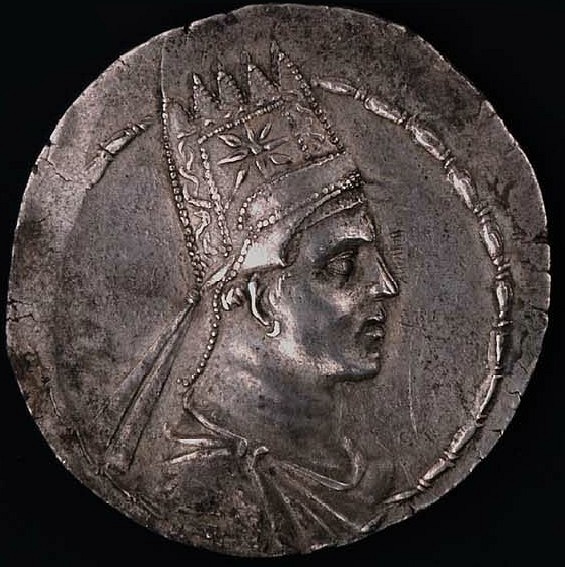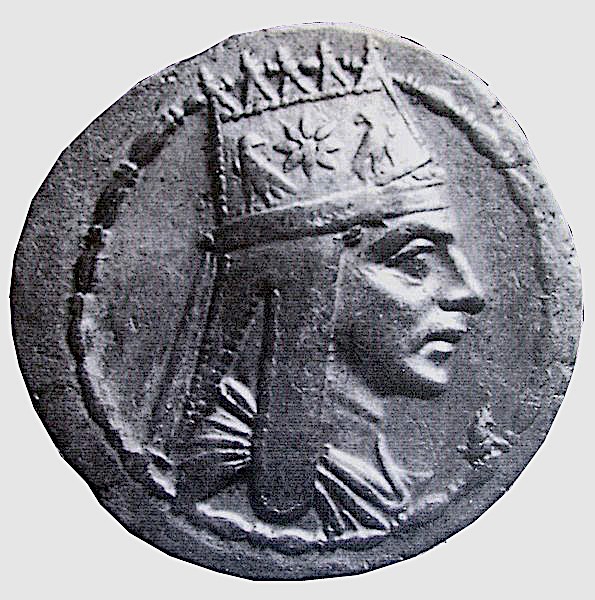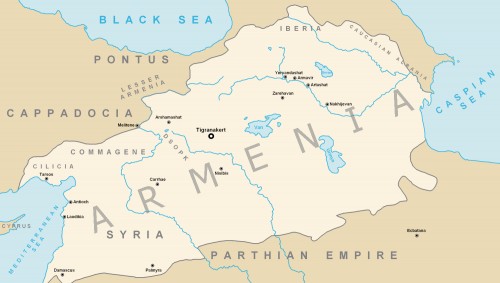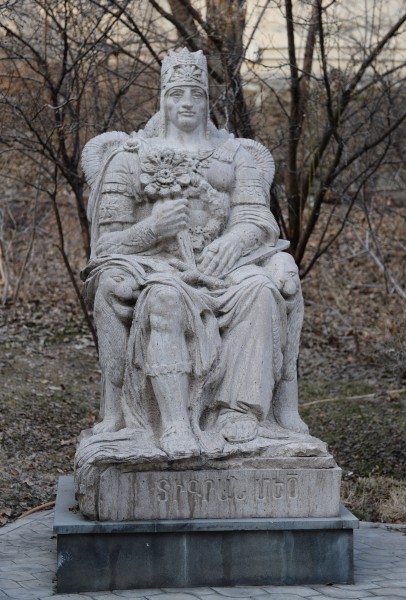Artaxiad Dynasty › Tigranocerta » Ancient origins
Articles and Definitions › Contents
- Artaxiad Dynasty › Who Was
- Tigranocerta › Ancient History
Ancient civilizations › Historical and archaeological sites
Artaxiad Dynasty › Who Was
Definition and Origins

The Artaxiad (Artashesian) dynasty ruled ancient Armenia from c. 200 BCE to the first decade of the 1st century CE. Founded by Artaxias I, the dynasty would ensure Armenia enjoyed a sustained period of prosperity and regional importance. One of several important Artaxiad rulers was Tigranes the Great, who greatly expanded his kingdom before its ultimate defeat to the Romans in the mid-1st century BCE. Thereafter, the kingdom would become a pawn in the wider politics and wars involving Rome and Parthia.
DECLINE OF THE ORONTID DYNASTY
The Orontid dynasty had ruled ancient Armenia as Persian satraps from the 6th century BCE, then they had governed under the suzerainty of the Macedonians and the Seleucid Empire following the region's conquest by Alexander the Great in the latter half of the 4th century BCE. The last of the Orontid dynasty to rule in eastern Armenia was king Orontes IV (to the Armenians, Yervand IV or Yervand the Last, rc 212-200 BCE). Yervand, who, like many of his predecessors, had given himself the title of king, moved the capital from Armavir to the newly founded Yervandashat, meaning “Yervand's Joy”. Around 200 BCE Yervand IV was murdered and Artaxias I (aka Artashes or Artaxerxes), backed by the Seleucid ruler Antiochus III (r. 222-187 BCE), was made the empire ’s satrap in Armenia. Contrary to the traditional view initiated by ancient authors, it seems likely that the Orontid and Artaxiad rulers did share a common ancestry as revealed by name conventions and recently discovered inscriptions on Armenian boundary stones.
ARTAXIAS HAS BECOME ONE OF THE MOST REVERED OF ALL ARMENIAN KINGS & THE SUBJECT OF POEMS & SONGS EVER SINCE HIS REIGN.
ARTAXIAS I
Antiochus probably thought a change of regime would reduce the increasing trend of Armenian independence from Seleucid overrule. To this end, he created two satraps: Artaxias in Armenia and Zariadris in Sophene to the southwest. However, when Antiochus was defeated by the Romans at the Battle of Magnesia in 190 BCE, Artaxias declared himself king and set about expanding his kingdom, first by marriage to Queen Satenik of Asian Iberia. Artaxias conquered part of Media Atropatene north of the Arax River while in the south, the areas of Phaunitis and Armenian Siunik, and in the west, Vaspurakan, were annexed.The kingdom was unified as never before with an administrative centralisation and such innovations as boundary stelae to proclaim property rights and the authority of the crown. No wonder, then, that Artaxias has become one of the most revered of all Armenian kings and the subject of poems and songs ever since his reign.
A new capital was founded on a peninsula of nine hills at Artaxata ( Artashat ) in 176 BCE. Hannibal, the great Carthaginian general, was said to have designed the city ’s fortifications when he served Artaxias following his defeat to the Romans.These and other features of the city are described by the historian RG Hovannisian:
The city contained a citadel on the height later called Xor Virap ( Khor Virap ) and was protected by extensive fortifications and a moat. Recent excavations have a revealed a major urban center with paved streets, public buildings, baths, shops, and workshops of various craftsmen…it rapidly became a major junction point between the trade route along the valley of the Araxes leading outward to Bactria and India and the one running northward to the Black Sea. (49)
Artaxias' long reign finally came to an end sometime between 165 and 160 BCE but his line continued with his two sons, first with the brief reign of Artavasdes (Artawazd) and then Tigranes I (Tigran I), whose succession date is unknown and who would rule until 95 BCE. Not much is known about either ruler beyond a few excavated coins corroborating their existence which previously had been suggested only by the appearance of their names in a few ancient texts.
TIGRANES II THE GREAT
After a rather dim period in the historical record for Armenia, a shining light suddenly arrives on the scene with a mass of documentation covering the greatest of Artaxiad kings, or indeed any Armenian king, Tigranes II (Tigran II) or Tigranes the Great (r. c 95 - c. 56 BCE). He was put upon the throne of Armenia by the Parthians after his uncle, the Armenian king Artavasdes I, had been forced to send Tigranes as a hostage to them. When his father Tigranes I died c. 95 BCE, Tigranes was sent back to Armenia to take his place on the throne. The new king had to cede the “Seventy Valleys” to the Parthians (a territory probably towards modern Azerbaijan) although he soon proved to be anything but a compliant client ruler.

Tigranes the Great
Tigranes took advantage of the Parthians being distracted by invasions on their eastern borders and set about expanding his own kingdom even further. First, he annexed the other part of traditional Armenia, the kingdom of Sophene, in 94 BCE. With formidable siege engines and units of heavily-armoured cavalry, he then re-took the “Seventy Valleys” and conquered Cappadocia, Adiabene, Gordyene, Phoenicia and parts of Syria, including Antioch. The Armenian king even sacked Ecbatana, the Parthian royal summer residence, in 87 BCE while the Parthians were struggling to deal with invading northern nomads. At its peak, Tigranes the Great's Armenian Empire stretched from the Black Sea to the Mediterranean. Not before or since would Armenians control such a huge swathe of Asia.
IT SEEMED THAT WHICHEVER SIDE ARMENIA CHOSE - ROME OR PARTHIA - THE SMALL KINGDOM CAUGHT BETWEEN THESE GREAT EMPIRES WOULD ALWAYS COME OFF SECOND BEST.
From 85 BCE Tigranes rather grandly began calling himself the “King of Kings”, although the title is further evidence that he left conquered monarchs to rule as vassals. The conquered states were obliged to pay tribute and populations were relocated to reduce dissension and increase loyalty wherever required. Tigranes was noted as an admirer of Greek culture and the capital city he founded in 83 BCE, Tigranocerta (aka Tigranakert, and of uncertain location), was famously Hellenistic in its architecture. The Greek language was likely used, along with Persian and Aramaic, as the language of the nobility and administration while commoners spoke Armenian. Persian elements continued to be an important part of the Armenian cultural mix, too, especially in the area of religion
Tigranes then made his major political blunder and allied himself with Mithridates VI, the king of Pontus (r. 120-63 BCE) and great enemy of Rome. Admittedly, Tigranes was married to Mithdradates' daughter Cleopatra and, really, it seemed that whichever side Armenia chose - Rome or Parthia - the small kingdom caught between these great empires would always come off second best.

Tigranes the Great's Armenian Empire
The Roman Republic, seeing the danger of such an alliance between the two regional powers, responded by attacking Pontus and when Mithridates fled to the court of Tigranes in 70 BCE, the Romans invaded Armenia. Tigranes was defeated by a Roman army commanded by the general Licinius Lucullus, Tigranocerta was captured in 69 BCE and the Armenian king was forced to abandon his conquests. Following another Roman attack c. 66 BCE, this time led by Pompey the Great, Armenia was made into a Roman protectorate. Thereafter, the state became a bone of contention between Rome and Parthia (and its successor, Sasanid Persia ) but Tigranes continued to rule most of Armenia as a vassal state of the Roman Empirewhich acted as a useful buffer to the Parthians until his death c. 56 BCE aged 85.
ROME, PARTHIA & DECLINE
Artavasdes II (rc 56 - c. 34 BCE), son of Tigranes II, was known as a philosopher king because of his literary works in Greek, none of which, unfortunately, survive. Armenia continued its precarious position between the Roman Empire in the west and Persia in the east. The Roman general Marcus Licinius Crassus obliged Artavasdes to support his campaign against the Parthians in 53 BCE but following its spectacular failure, when the richest ever Roman lost both his army and his head, an alliance was re-formed between Armenia and Parthia and cemented by Artavasdes betrothing his sister to the eldest son of the Parthian king Orodes II (r. 57-37 BCE).

Marcus Licinius Crassus
However, in 36 BCE, the region was again destabilised when another Roman general, this time Mark Antony, passed through, and the Armenians were, once more, asked to provide troops. Once again, the Romans were defeated by their nemesis the Parthians. In 34 BCE Antony then moved against the Artaxiads, taking Artavasdes to Alexandria where the flamboyant triumvir controversially celebrated an unofficial triumph for his victories in Armenia. Artavasdes would later be executed by Queen Cleopatra.
Meanwhile, the Parthians installed Arteses (Artashes) II as king of Armenia in c. 30 BCE, one of the sons of Artavasdes. Then, in 20 BCE, Rome reasserted its claim over the region when Emperor Augustus sent Tiberius to reinstall a king of Armenia who was more loyal to imperial Rome: Tigranes III. In a game of musical thrones, the Parthians installed Tigranes IV in 8 BCE, who was then briefly replaced by the Roman-backed Artavasdes III in 5 BCE, before regaining his seat in 2 BCE, although this time he had to share it with his sister Erato. Three more changes would occur over the next decade but the music was about to stop for good.
The volatile political reality of the region in this period is reflected in the short reigns and frequent change of subsequent monarchs: nine rulers up to the first decade of the 1st century CE. The decline of the Artaxiads was also in part due to the internal factions which had been created by the nobility splitting into either pro-Roman or pro-Parthian factions. In unclear circumstances, the Artaxiads were succeeded by the next dynasty to dominate Armenian affairs, the Arsacid (Arshakuni) dynasty, when their founder, Vonon (Vonones) took the throne in 12 CE.
This article was made possible with generous support from the National Association for Armenian Studies and Researchand the Knights of Vartan Fund for Armenian Studies.
Tigranocerta › Ancient History
Definition and Origins

Tigranocerta (Tigranakert) was a city in the southwest of ancient Armenia founded and made capital by Tigranes the Greatin 83 BCE. Famous for its riches and fine buildings, as well as its mix of Hellenistic and Persian culture, the city, despite possessing impressive fortifications, was captured twice by Roman armies in 69 BCE and 59 CE. Continuing as an important settlement into Late Antiquity, it was then abandoned and its precise location has been lost in the mists of time.
FOUNDATION
One of the greatest of the Artaxiad kings, or indeed any Armenian king, was Tigranes II (Tigran II) or Tigranes the Great (rc 95 - c. 56 BCE). He expanded his kingdom considerably and at its peak, the Armenian Empire stretched from the Black Sea to the Mediterranean. Not before or since would Armenians control such a huge swathe of Asia. Tigranes was noted as an admirer of Greek culture - not insignificantly, his wife was Cleopatra of Pontus - and he followed the Hellenistic trend of rulers founding a new city and naming it after themselves. Tigranocerta, meaning “Tigranes' foundation”, was founded in 83 CE and it was made the capital city of the new empire of Armenia.
TIGRANOCERTA HAD IMPRESSIVE FORTIFICATIONS WITH THE WALLS REACHING A HEIGHT OF 22-26 METRES.
Due to a lack of any archaeological evidence, the precise location of the city is not known beyond that is was somewhere in the southwest of ancient Armenia, which was a more central position than the old capital of Artaxata ( Artashat ) given the kingdom's recent expansion. It was probably located along the River Tigris on the Persian Royal Road trade route with two possible candidates being near modern Diyarbakir or Siirt (both in today's southeast Turkey ). An added advantage was that the location in the south was much closer to the newly acquired and immensely rich territory of Syria. One of the negative aspects of the new location was its vulnerability to attack and relative isolation from the Armenian heartland - a fact which would be twice exploited by Roman field commanders.
A COSMOPOLITAN CITY
Tigranocerta was famously Hellenistic in its architecture although it was specifically designed to reflect the mixed cultural heritage of the country with Greek, Persian, and Armenian elements. The city had impressive fortifications with the walls reaching a height of 22-26 metres and incorporating stables, such was their thickness. There were also many amenities including a Greek theatre, a palace built in the Persian style outside the city walls, a fort, hunting parks and pleasure gardens.Tigranes was said to have forcibly relocated (a traditional figure of) 300,000 people to the new capital form 12 different cities, most of them in Cappadocia. According to the 1st-century BCE Greek historian and geographer Strabo, the largest contingent of forced migrants came from Mazaka in Cappadocia.

Tigranes the Great
As the centre of a prospering empire with trade links to both Mesopotamia and Phoenicia, material wealth flooded into the city from all directions, as the 1st-2nd-century CE Greek historian Plutarch here notes:
…the city was also full of wealth…since every private person and every prince vied with the King in contributing to its increase and adornment. ( Lucullus, 26:2)
The fabled wealth of Tigranocerta at this time was still dazzling historians writing in the 5th century CE, as in this description of Tigranes by the Armenian historian Movses Khorenatsi in his History of the Armenians :
He multiplied the stores of gold and silver and precious stones, of garments and brocades of various colours, both for men and women, with the help of which the ugly appeared as wonderful as the handsome, and the handsome were altogether deified at the time…The bringer of peace and prosperity, he fattened everyone with oil and honey. (quoted in Hovannisian, 56-7)
Such a prosperous city attracted people from all over, and many Greek philosophers and rhetoricians were invited to share their ideas at Tigranes' court. Greek actors were even brought in to inaugurate the theatre of the capital. Further reflecting the cosmopolitan nature of the city, and the empire in general, the Greek language was likely used, along with Persian and Aramaic, as the language of the nobility and administration while commoners spoke Armenian. Persian elements continued to be an important part of the Armenian cultural mix, too, especially in the area of religion and the formalities of the court such as titles and dress.
BATTLE OF TIGRANOCERTA 69 BCE
Tigranes may have built a large empire but he made a serious misjudgement when he allied himself with Mithridates VI, the king of Pontus (r. 120-63 BCE). Mithridates was a great enemy of Rome with the two states waging war for over two decades.Admittedly, Tigranes had been married to Mithridates' daughter Cleopatra since 92 BCE and, really, it seemed that whichever side Armenia chose - Rome or Parthia - the small kingdom caught between these great empires would always come off second best.

Statue of Tigranes the Great
The Roman Republic saw the danger of such an alliance between the two regional powers, a suspicion which was confirmed by a joint Tigranes-Mithridates campaign against the Roman client state of Cappadoccia. The Romans responded by attacking Pontus, and when Mithridates fled to the court of Tigranes in 70 BCE, they asked for the former to be handed over. When Tigranes refused, the Romans invaded Armenia. Tigranes was defeated by a Roman army commanded by the general Licinius Lucullus right outside the walls of the capital. Tigranocerta was then besieged in October 69 BCE as described by the 2nd-century CE historian Appian in his Mithridatic Wars :
[The Romans commanded by Sextilius] plundered the palace outside the walls, drew a ditch around the city and tower, moved machines against them, and undermined the wall. While Sextilius was doing this, Tigranes brought together some 250,000 foot and 50,000 horse. He sent about 6,000 of the latter to Tigranocerta, who broke through the Roman line to the tower, and seized and brought away the king's concubines. (17:84)
The siege, nevertheless, continued and following the betrayal of the Greek garrison, Tigranocerta was captured and sacked.The conquering Romans were amazed at the wealth of Tigranocerta even after Tigranes had already managed to spirit away part of his royal treasury and personal harem. The looters found 8,000 talents in gold while each Roman legionary received 800 drachmas. The inhabitants abandoned the city following its destruction, many of whom, of course, had been forcibly put there in the first place and were only too glad to return to their homelands.
THE CONQUERING ROMANS WERE AMAZED AT THE WEALTH OF TIGRANOCERTA EVEN AFTER TIGRANES HAD ALREADY MANAGED TO SPIRIT AWAY PART OF HIS ROYAL TREASURY.
Lucullus then moved to attack the important city of Artaxata, but with winter coming on, his supply line dangerously thin and exposed, and even a mutiny amongst his own troops, the Roman general was forced to withdraw. Tigranes' army harried the retreating Romans using guerrilla tactics, and Lucullus was recalled to Rome in 67 BCE. The respite would not last for long as the Roman Senate proved determined to stamp its authority on the region once and for all. In 66 BCE another Roman army headed eastwards, this time led by Pompey the Great. Roman victories followed, and Tigranes was shorn of his empire and forced to pay a huge tribute to Pompey. Armenia was made a protectorate of Rome, but at least Tigranocerta was rebuilt by Pompey and then reinhabited.
ROMAN-PARTHIAN WAR 58-63 CE
The city once again found itself under attack during the Roman-Parthian war of 58 to 63 CE. Armenia was, yet again, disputed territory in a greater game of empires, and in 54 CE the Roman emperor Nero (r. 54-68 CE) sent his best general Gnaeus Domitius Corbulo to assert Rome's position in the region following the attempt by Parthian king Vologases I (aka Vagharsh, rc 51- up to 80 CE, dates disputed) to put his own brother Tiridates on the Armenian throne.

Parthian Archer
During the campaign Tigranocerta, then the country's second most important fortress city after the capital Artaxata, fell to the Romans in 59 CE:
Soon afterwards, Corbulo's envoys whom he had sent to Tigranocerta, reported that the city walls were open, and the inhabitants awaiting orders. They also handed him a gift denoting friendship, a golden crown, which he acknowledged in complimentary language. Nothing was done to humiliate the city, that remaining uninjured it might continue to yield a more cheerful obedience. (Tacitus, Annals, Bk. 14:24)
By 60 CE, Corbulo could claim to rule over all of the Kingdom of Armenia and Tiridates was forced to flee back to his brother in Parthia. In the same year, Tigranes V (rc 60-61 CE), who had impressive royal connections being the grandson of Herod the Great, was set on the throne as a pro-Roman monarch. Tigranes V's cameo reign came to an abrupt end when the Parthians sent an army to besiege him in Tigranocerta in 62 CE. The city held out, but when Corbulo returned to the field from Syria in 63 CE, his presence alone persuaded Parthia to sign the Treaty of Rhandia. Under this treaty, it was agreed to equally share the responsibility of ruling Armenia between Rome and Parthia.
LATE ANTIQUITY
Continuing as an important regional city over the next few centuries, Tigranocerta came directly under Roman governance in 387 CE following an agreement between Rome and the Sasanian Empire. The new overlords then renamed the city Martyropolis. In 536 CE, when the Byzantine emperor Justinian I reorganised the administration of the region, Armenia was split into four areas or provinces and Martyropolis made capital of Armenia IV. In 640 CE, when the Arab Umayyad Caliphate conquered Armenia, the city was renamed again, this time Mayarfarkin.
This article was made possible with generous support from the National Association for Armenian Studies and Researchand the Knights of Vartan Fund for Armenian Studies.
LICENSE:
Article based on information obtained from these sources:with permission from the Website Ancient History Encyclopedia
Content is available under License Creative Commons: Attribution-NonCommercial-ShareAlike 3.0 Unported. CC-BY-NC-SA License